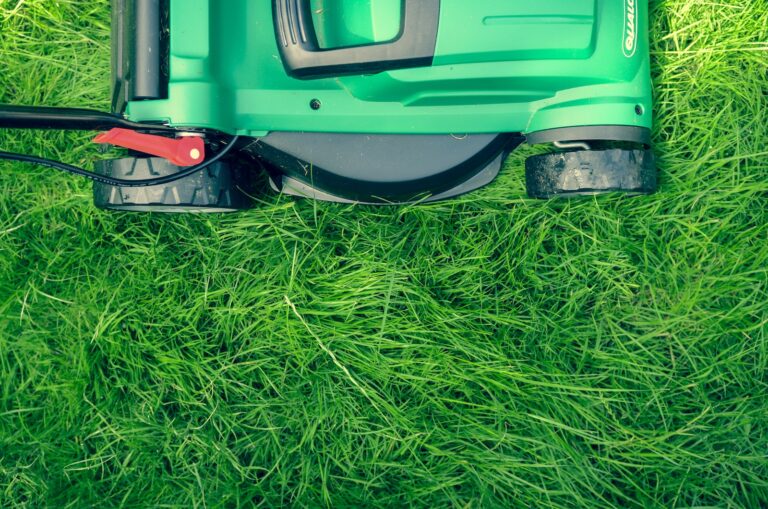How to maintain a green lawn during winter?

Winter doesn’t necessarily mean giving up on your lawn. While the snow might cover up the green beauty of your grass, there are several ways you can maintain a thriving lawn even in the colder months.
Whether you’re a gardening enthusiast or simply want to keep your backyard looking neat during winter, this blog post will provide you with all the tips and tricks you need to know to keep your grass healthy and vibrant throughout the season.
With just a little bit of effort and some easy-to-follow advice, you can have a green oasis right outside your window – no matter how cold it gets!
Preparation before winter

As the weather cools down and winter approaches, it’s important to take some steps to prepare your lawn. With a little care and attention, you can keep your lawn looking green and healthy all winter long. Here are a few tips:
-Aerate your lawn: This will help improve drainage and prevent puddling in the snow.
-Apply a winterizer fertilizer: This will help ensure your lawn gets the nutrients it needs to stay strong through the winter.
-Mow your lawn one last time: Cut your grass a bit shorter than normal to prevent matting under the snow.
By following these simple tips, you can keep your lawn in great shape all winter long!
Fertilizing
Fertilizing your lawn is one of the key steps to keeping it green and healthy during winter. Depending on the type of grass you have, you will need to fertilize at different times throughout the year.
For example, cool-season grasses like bluegrass and ryegrass should be fertilized in late fall or early winter, while warm-season grasses like Bermuda and zoysia should be fertilized in late winter or early spring.
When selecting a fertilizer, look for one that is specifically designed for lawns and contains a balanced blend of nutrients. Apply fertilizer according to the manufacturer’s directions, taking care not to overdo it, as this can damage your grass.
Watering your lawn regularly is also important to keep it green during winter. If you live in an area with snowfall, let the snow melt on your lawns naturally – resist the urge to shovel it! This will provide much-needed moisture to your grass.
Selecting grass varieties
When it comes to maintaining a green lawn during winter, one of the most important things you can do is select the right grass variety. With so many different types of grasses out there, it can be hard to know which one is best for your climate and soil type.
If you live in an area with a colder climate, you’ll want to choose a grass that is tolerant to cold weather and can survive long periods of snow cover. Fescue and bluegrass are two good options. If you live in a milder climate, bermudagrass or zoysiagrass are two grasses that will stay green all winter long.
No matter what type of grass you have, however, there are some basic lawn care tips that will help keep your lawn looking its best during the winter months. Be sure to mow your lawn regularly (about once a week) and keep the blades sharp.
This will help prevent your grass from getting damaged by the cold weather. You should also fertilize your lawn in the fall to give it a little boost going into winter. And finally, make sure you rake up any leaves that fall on your lawn so they don’t smother the grass underneath.
Weeding
It’s important to keep up with your lawn maintenance even during the winter months. This means regular mowing, fertilizing, and of course, weeding. Weeds can be a real nuisance in the winter, as they can take over your lawn quickly if you’re not careful.
There are a few things you can do to help prevent weeds from taking over your lawn in the winter. First, make sure you mow regularly and keep your grass trimmed short. This will help prevent weed seeds from taking root in your lawn.
Second, use a herbicide specifically designed for winter weeds. Early spring is the best time to apply herbicide, but it can also be effective in late fall or early winter. Finally, make sure you keep an eye on any bare spots in your lawn, as these are prime locations for weeds to take hold.
Maintenance during winter season
During winter, it is important to keep your lawn green and healthy. Here are some tips on how to do so:
-Aerate your lawn regularly. This will allow oxygen and nutrients to reach the roots of your grass, which is essential for its health.
-Fertilize your lawn every few weeks. This will help it stay green and prevent it from turning yellow or brown.
-Water your lawn regularly. Grass needs water to survive, so make sure to give it a good watering at least once a week.
-Mow your lawn regularly. This will help prevent it from getting too long and scraggly.
By following these tips, you can keep your lawn looking great all winter long!
Remove leaf litter, dead grass and moss
In order to maintain a green lawn during winter, you will need to remove leaf litter, dead grass and moss. This can be done by using a rake or a lawn mower. Raking will remove the thatch from your lawn, which is a build-up of organic matter that can impede grass growth.
It is important to remove this debris so that your grass can grow freely. Lawn mowers are also effective at removing leaves, dead grass and moss. Be sure to set the blades of your lawn mower to the highest setting so that you do not damage the roots of your grass.
Use snow mold prevention
As the temperatures begin to dip and snow starts to fall, it’s important to take steps to prevent snow mold from taking over your lawn. Snow mold is a type of fungus that affects grass blades and can cause them to turn brown or yellow. It thrives in wet, compacted snow and can damage your lawn if left unchecked.
There are two main types of snow mold – gray snow mold and pink snow mold. Gray snow mold is the more common of the two and is often seen in early spring when the snow melts and reveals brown or yellow patches on the lawn. Pink snow mold is less common but can still be found in some areas. This type of snow mold appears as pinkish-red streaks on the grass and is most commonly seen in late winter or early spring.
There are a few things you can do to prevent snow mold from damaging your lawn. First, make sure to rake up any leaves that fall on your lawn before the first frost. Leaves that are left on the ground will trap moisture and create an ideal environment for snow mold to thrive.
You should also avoid walking on your lawn when it’s covered in snow, as this will compact theSnowand make it more difficult for the grass blades to recover come springtime. Finally, apply a layer of mulch to your garden beds before the first frost hits.
Watering practices for a green lawn during winter
Watering your lawn during the winter months is important to keeping it green and healthy. Here are a few tips to help you water your lawn efficiently during winter:
-Water early in the day: Watering early in the day will allow the grass to absorb the water before it evaporates.
-Water deeply: Watering deeply means applying enough water so that it penetrates the root zone. This helps promote deep root growth, which is important for a healthy lawn.
-Avoid overwatering: Overwatering can lead to fungal diseases, so be sure to only apply enough water to keep the grass moist.
Avoid over-watering
While it is important to keep your lawn hydrated during winter, you should avoid over-watering. This can cause problems such as overwinter kill, which is when the grass becomes oversaturated and dies.
To prevent this, water your lawn only when necessary and check for signs of overwatering such as puddling or runoff. If you notice either of these, reduce the amount of water you are giving your lawn.
Use deep watering methods
Water is the key to any healthy lawn, but during winter, your lawn may need less water than you think. Many people believe that they need to water their lawns more during winter to keep them green, but this is actually a myth. your lawn will actually dormant during winter, meaning it will be less active and won’t need as much water.
There are two main methods of watering your lawn during winter: shallow watering and deep watering. Shallow watering is when you water the surface of the soil just enough to wet the grass roots. This method is not effective in getting water down to the roots of the grass, so it’s not recommended for watering during winter.
Deep watering is when you water deeply and slowly so that the water has time to soak down to the roots of the grass. This is the best method for watering your lawn during winter because it will help keep the roots of the grass healthy and hydrated. To deep water your lawn, use a garden hose with a sprinkler attachment or a drip irrigation system. Water your lawn for 30 minutes to an hour so that the water has time to soak down deep into the soil.
Winter Weed Management
Many people think that once the colder weather sets in, they can just sit back and relax when it comes to their lawn care routine. However, this couldn’t be further from the truth!
As temperatures start to drop, grass and weeds go into survival mode and begin to store nutrients in their roots in preparation for winter. This means that if you’re not careful, your lawn could be overrun with weeds come springtime.
That’s why it’s important to stay on top of your weed management routine throughout the winter months. Here are a few tips to help you keep your lawn green and weed-free all season long:
- Inspect your lawn regularly and remove any weeds that you see. The sooner you can get rid of them, the better.
- If there are areas of your lawn that are particularly weed-prone, consider treating them with an herbicide or weed preventer.
- Be sure to fertilize your lawn regularly during the winter months. This will help it stay strong and healthy, making it more resistant to weeds.
- Keep an eye on the temperature and moisture levels in your yard. If it gets too cold or dry, grass and weeds will start to go dormant. Pay special attention to these conditions during late fall and early spring when they can be most unpredictable.
By following these simple tips, you can help ensure a green and healthy lawn all winter long!

James is a passionate writer and gardener with years of experience in home gardening. He is the author of several articles and blog posts on HomeGardenBlog.com, a platform where he shares his expertise and love for plants and gardening with the world.







